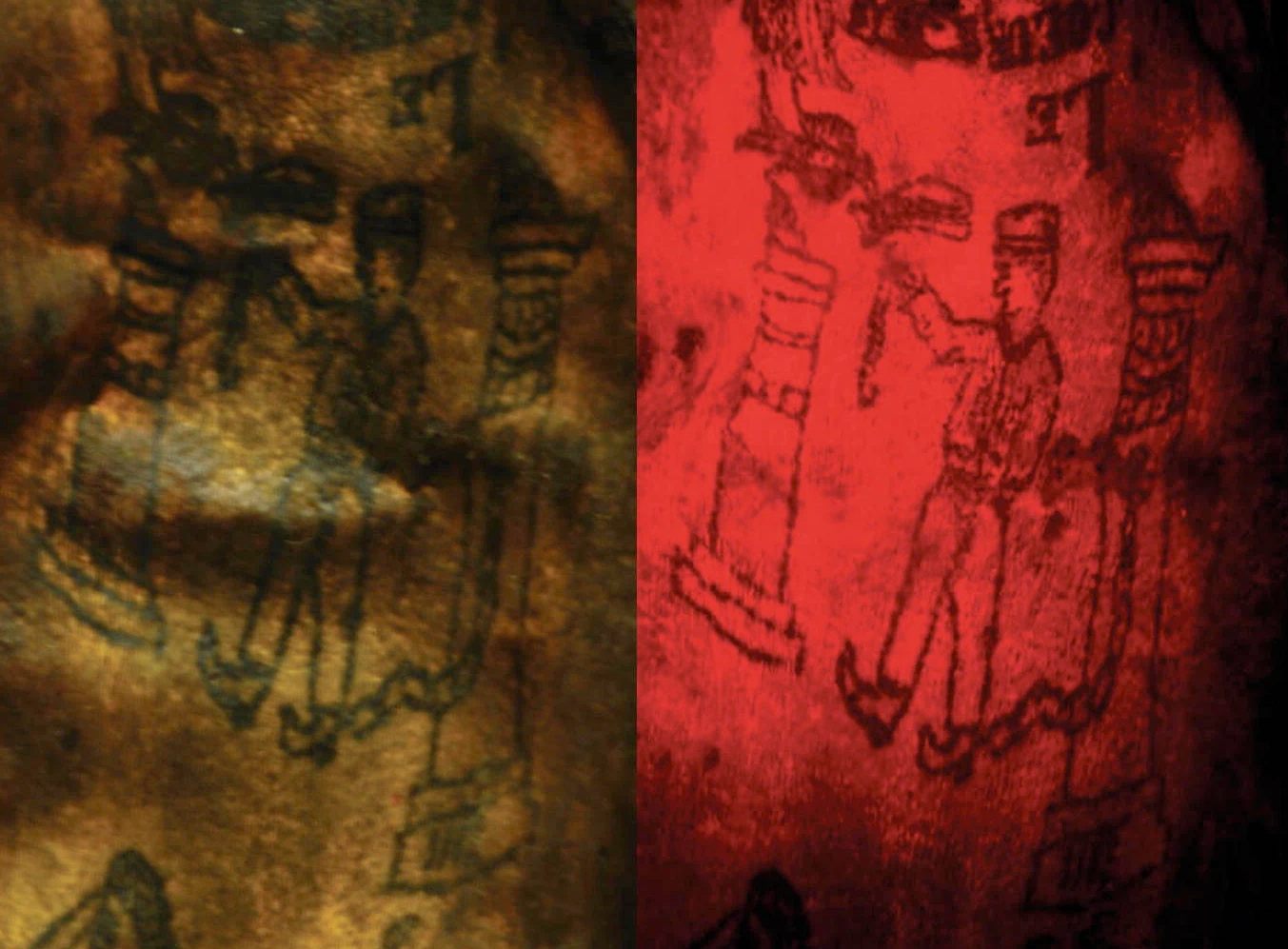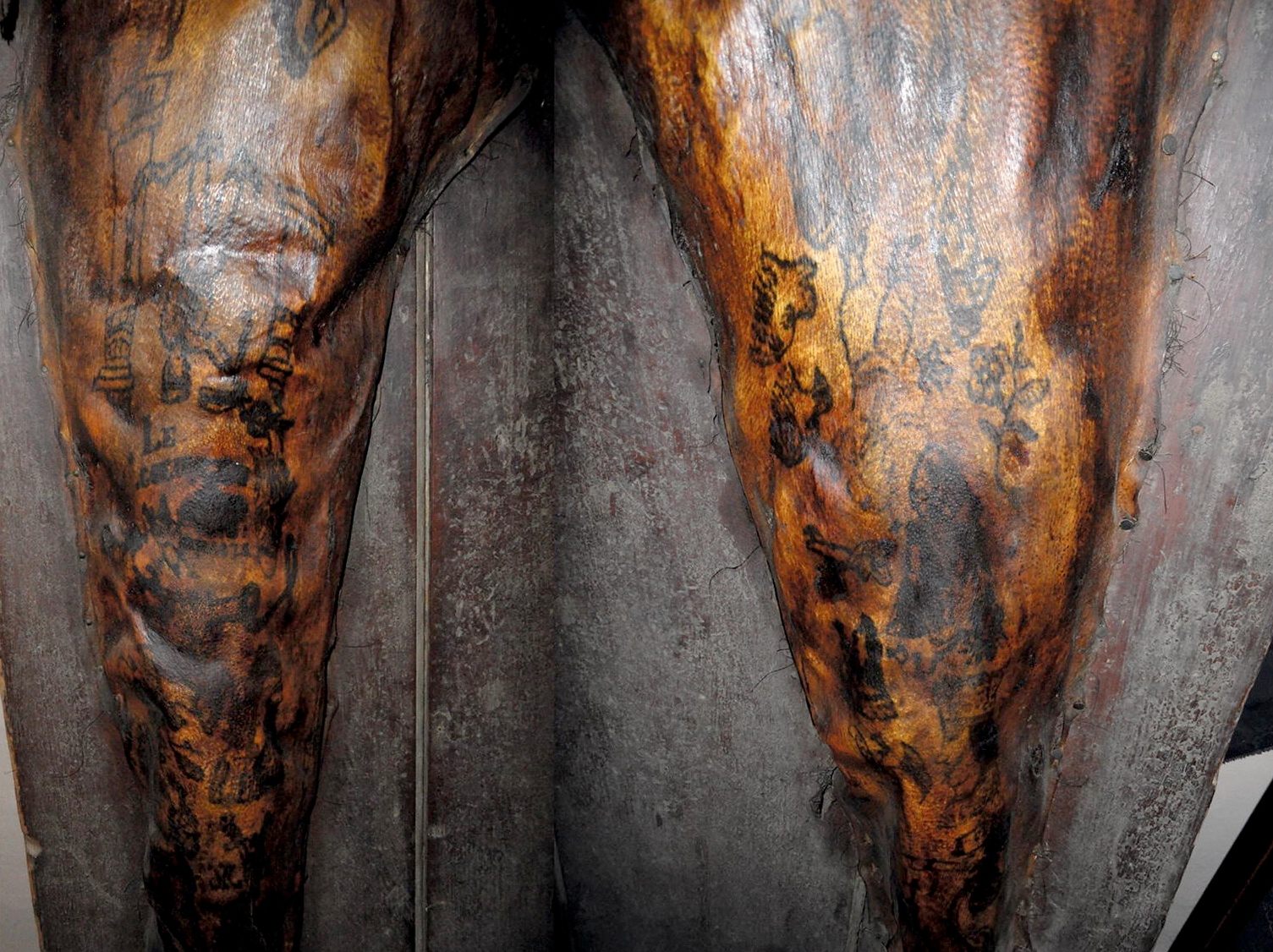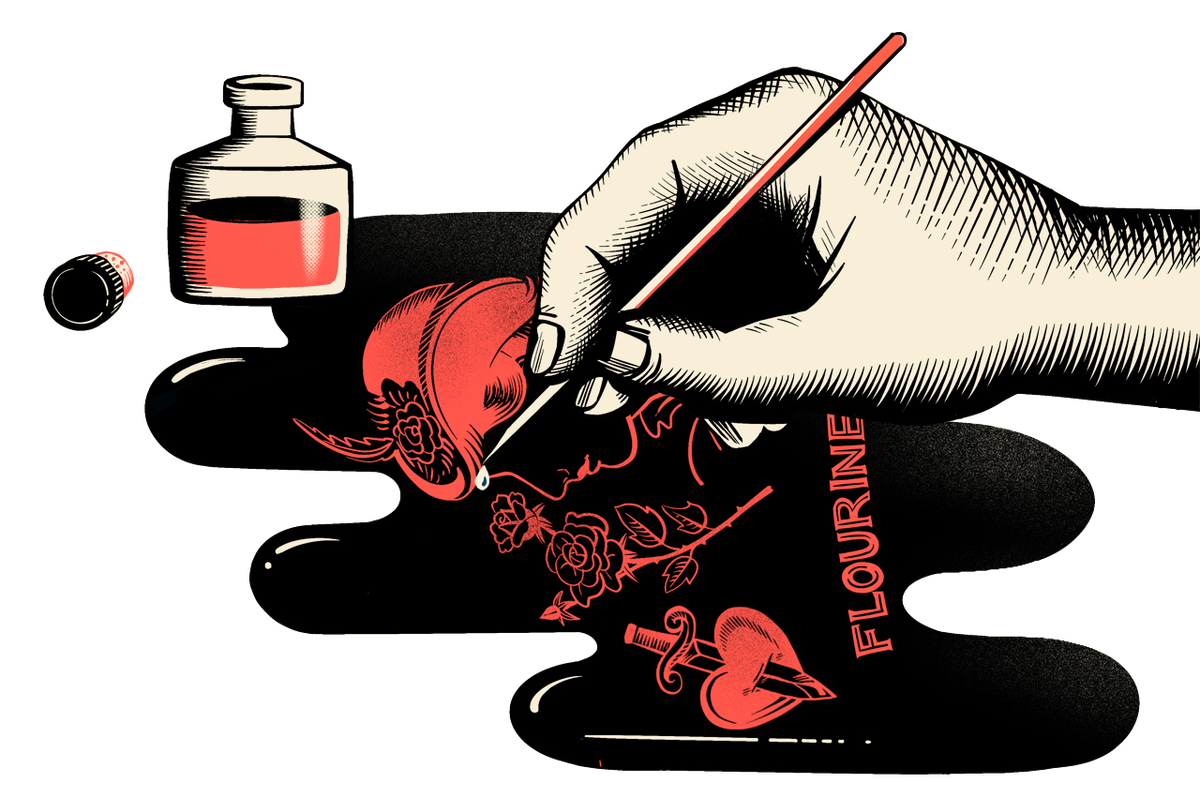
Tattoos, Identity, and The Disturbing Fate of ‘Monsieur Bonheur’
Clues to who the 19th century Frenchman was can be read on his unusually preserved remains.
When Gemma Angel met Monsieur Bonheur, she wasn’t quite sure what to expect. Angel, pursuing her doctorate at the University College London at the time, was studying a collection of hundreds of preserved pieces of tattooed skin from European soldiers, and she was no stranger to the unconventional and the macabre. But her first glimpse of Bonheur, in a private collection in London in 2010, still managed to surprise.
“Bonheur was in his library, covered up, just leaning against the wall,” Angel says. “And it was kind of a shock, but also fascinating.”
Angel had come to see the largely complete, tattooed skin of a 19th century Frenchman, which had been preserved, stuffed with horsehair, and nailed to a board. The remains, acquired some 20 years ago from an antique dealer in Paris, are currently in the possession of an individual who has asked to remain anonymous. That individual, and a handful of researchers granted access to study the unidentified Frenchman, call him “Monsieur Bonheur”—French for “happiness”—after one of his most prominent tattoos.

When she first saw the remains, Angel was writing her dissertation on a collection of tattooed skin fragments held by the Wellcome Collection in London. The specimens date from the late 19th and early 20th century, a time when criminologists sought connections between physical characteristics, such as tattoos, and antisocial behavior. She says Bonheur is different, both for the near-completeness of his remains and their presentation. While there is no documentation to support the claim, the story accompanying Bonheur from Paris to London is that he was a convicted criminal who, after his execution, was displayed on the courthouse door as a warning to would-be wrongdoers.
“He’s definitely not well preserved, and he’s not presented in the context of a scientific collection,” says Angel, now at the University of Leicester, where she studies the history and anthropology of the European tattoo. “Bonheur speaks to something much darker, really.”
“It may be that this overall ‘preparation’ represents something similar to what were called ‘sideshow mummies’ in the U.S. during the 19th and early 20th century,” said University of Bournemouth biological anthropologist Martin Smith, lead author of a recent paper on Bonheur in Archaeological and Anthropological Sciences, in comments to New Scientist. He added: “Unclaimed, embalmed bodies from institutions and funeral directors were exhibited for profit, commonly with an ‘exciting’ (but unverified) story attached to them.”
The real story of the man who would become Bonheur remains unknown, though clues may be gleaned from the more than 50 tattoos he accumulated over the course of his life. Images of men and women intermingle with flora and fauna across his legs, arms, and chest. Scenes of violence and beauty sit side by side: sword and daggers, the moon and stars. Symbols of nationalities mix freely, with a Gallic rooster strutting near a Celtic cross and a Venezuelan flag. Their diversity might inspire an imagined life of adventure: Perhaps the man was a soldier or sailor, calling at far-flung ports.
But what we can say about the man with confidence is much more limited. Basic physical traits confirm he was male; language and other elements of his tattoos indicate he was probably a Frenchman, who died near the end of the 19th century. His cause of death is unknown. An incision running down the length of his chest is consistent with an autopsy, which suggests someone with some degree of medical knowledge may have been involved with the body’s preparation. Most of the skin from the anterior, or front of his body, was removed in several large sections. Then, the remains were essentially taxidermied, says John Troyer, author of Technologies of the Human Corpse. Troyer, the director of the Centre for Death and Society at the University of Bath, was not involved in the recent research but is familiar with the paper.
The way Bonheur’s remains were preserved indicates the motive was not scientific. “A taxidermied specimen, like a fully tattooed body, becomes about visual spectacle,” Troyer says. “And really about narrative and less about any kind of scientific study.”
“It speaks to something quite macabre, actually. There’s a kind of morbid fascination with the idea of exemplary punishment,” Angel says.
Few people directly connected to Bonheur were willing to be interviewed on record, including the individual in possession of the remains. Smith and his co-authors either declined to comment directly for this piece or could not be reached, despite multiple attempts. That reticence isn’t uncommon when it comes to human remains previously treated as specimens or spectacles. “A lot of natural history museums have these collections of tattoos,” Troyer says. “And they just don’t know what to do with them.”
Matt Lodder, a senior lecturer in art history and director of American studies at the University of Essex, has had people tell him about remains allegedly in their personal collections, and is aware of another individual, tattooed and preserved similarly to Bonheur, kept out of public sight in an Edinburgh museum.
Many such remains date to the 19th century, a time of fascination with collecting “curiosities,” and few ethical restrictions. “It was a Wild West, really,” Lodder says. “There were these doctors who just thought stuff was interesting, whether it was a tattoo or a weird ailment. They’d just sort of hack it off and keep it in a jar.”

Today, human remains in museum collections pose difficult questions. It’s often impossible to know their provenance, or whether they were collected ethically. Remains in private collections, such as Bonheur, present additional challenges, Lodder says.
Troyer agrees, adding that Bonheur has value as a cautionary reminder of a time when collectors thought little of taking and preserving human remains, without consent from, or regard for, the individual.
In the case of Bonheur, his tattoos may have played a role in why his remains were chosen to be preserved and possibly displayed. While tattooing is a global tradition that dates back more than 5,000 years, European attitudes toward it have swung back and forth dramatically over the last millennium.
Many medieval Christian pilgrims who traveled from Europe to Jerusalem would get tattoos at their destination to commemorate their journey. One shop still in business in Jerusalem today, Razzouk Ink, traces its history back 700 years. As networks of global trade—as well as colonization and conflict—grew, many European travelers were exposed to cultures in which tattoos signified deep community connections, status, or other core aspects of an individual’s identity. European sailors, soldiers, merchants, and others began returning home with tattoos that had personal meaning for them.

“The things people are tattooing on their bodies are the things they feel most bluntly about,” Lodder says. “It’s the things they love, the things they hate.”
By the 19th century, even many wealthy Europeans, including royalty, sported tattoos. King Frederick IX of Denmark, for example, had a number of tattoos from his time in the military. In 1881, while visiting Japan, Prince George of Wales—the future King George V of England—wrote of getting a dragon tattooed on one arm and a tiger on the other, an event corroborated in the diary of his tutor, John Dalton.
As tattoos grew more common during this period, however, some Europeans began to associate them with immorality and criminality, says Angel. The idea, rooted in racism and classism, appears to have grown out of a desire to keep “respectable” Europeans separate from cultures they viewed as inferior or degenerate.
Early 20th century French criminologist Alexandre Lacassagne carried out extensive research on tattooed criminals, attempting to find connections between criminal behavior and aspects of a tattoo such as theme or location on the body. He did not succeed. His work, however, left a collection of preserved tattoos for present-day researchers to study—though his focus on tattooed criminals also created a blind spot, says Lodder. “If you’re a normal person, your tattoos just aren’t recorded for history,” he says.
Whether Bonheur was a criminal remains uncertain, but Smith and colleagues’ recent research, using a range of different imaging techniques, has revealed new details about his dozens of tattoos, many of which were visible only through infrared or multispectral light. The researchers were also able to date the wooden frame around the remains to between 1846 and 1876.
Of his tattoos, an anchor, along with the words “Vive La Flotte” (“long live the fleet”), could mean Bonheur was a sailor. Other images also suggest a man well-traveled, including the Venezuelan flag and figures dressed as French soldiers in North African colonies. Some tattoos imply love or heartache, such as the portrait of a woman with the name “Flourine” beside it.

A few of the tattoos suggest darker periods in Bonheur’s life. One proclaims “Mort aux Commissaires,” or “death to commissioners.” Another tattoo depicts a man chained to a pillar with the date 1883. A bird soars nearby, bearing in its beak the word liberté. “Many of the preserved samples of tattooed skin collected in France and elsewhere during the 19th century were taken from convicts who had died in prison,” Smith told New Scientist. The dated tattoo “could be interpreted as…depicting a prisoner either sentenced, or perhaps due for release, in 1883.”
But to begin to sketch a story for Bonheur based solely on his tattoos is to move beyond the realm of evidence and into speculation. Like drawing constellations by linking stars in the night sky, this kind of narrative imposition offers a wealth of possibilities and very little hard truth.
Still, his distinctive tattoos could one day help identify who Bonheur was. If he really had served in the military or done time in prison, records of those events mentioning his tattoos might still exist, says Lodder. “I would hazard a guess that someone who’s familiar with 19th century French criminological records could probably find this guy,” he says.
Angel says that discovering more about the circumstances around Bonheur’s preservation would likely also help craft a better biography for him. “I’d like to know more about where this artifact came from, who put it together,” she says.
For now, however, we’re left with a collection of clues, and more questions than answers about the life of the man who, in death, became Monsieur Bonheur.

































Follow us on Twitter to get the latest on the world's hidden wonders.
Like us on Facebook to get the latest on the world's hidden wonders.
Follow us on Twitter Like us on Facebook